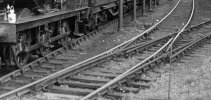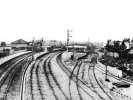Yindee8191
Member
- Joined
- 16 Mar 2019
- Messages
- 161
The bay platforms at the east end of Lincoln Central only have access onto the Down leading away from the station, and only the line towards Grimsby has a crossover in the right direction, which means that trains can’t terminate in those platforms from Sleaford, at least not without running wrong-line for several miles. While obviously the bays aren’t used for services on these lines, it seems unnecessarily operationally limiting to have no ability for trains to get into those bays from one of the two lines at that end of the station.


